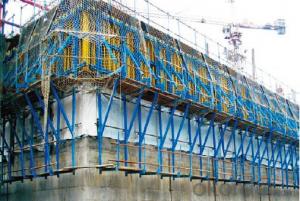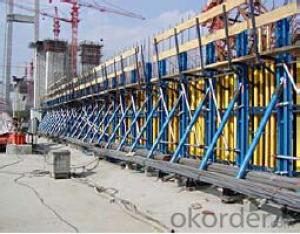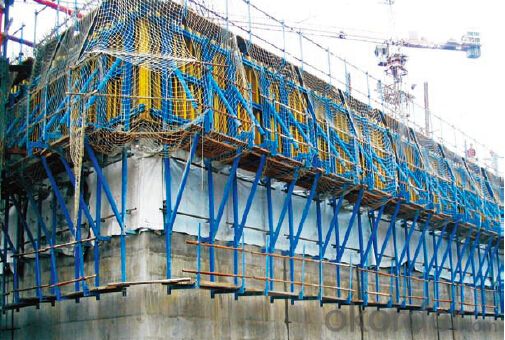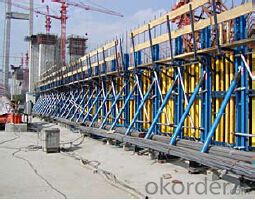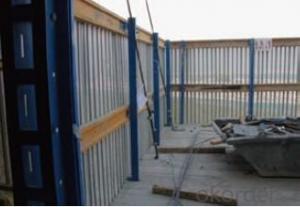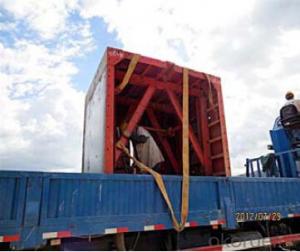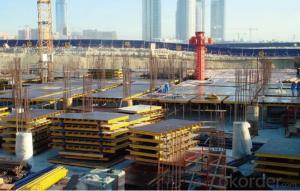Single-Side Climbing Bracket for formwork and scaffolding systems
- Loading Port:
- Tianjin
- Payment Terms:
- TT OR LC
- Min Order Qty:
- 50 m²
- Supply Capability:
- 1000 m²/month
OKorder Service Pledge
OKorder Financial Service
You Might Also Like
Single-side Climbing Bracket SCB180:
With CNBM SCB 180 climbing systems, the loads from the fresh concrete pressure are
transferred through the brackets by means of V-strongbacks and compression braces into the
scaffold anchors.
Typical applications for the SCB 180 are dams, locks, cooling towers, pier heads, tunnels, and
bank vaults.
The formwork is simply tilted backwards when striking takes place. The 1.80 m wide bracket
requires only a minimum of space.
Characteristics:
◆ Economical and safe anchoring
The M30/D20 climbing cones have been designed especially for single-sided concreting using
SCB180 in dam construction, and to allow the transfer of high tensile and shear forces into the still
fresh, unreinforced concrete. Without wall-through tie-rods, finished concrete is perfect.
◆ Stable and cost-effective for high loads
generous bracket spacings allow large-area formwork units with optimal utilization of the bearing
capacity. This leads to extremely economical solutions.
◆ Simple and flexible planning
With SCB180 single-sided climbing formwork, circular structures can also be concreted without
undergoing any large planning process. Even use on inclined walls is feasible without any special
measures because additional concrete loads or lifting forces can be safely transferred into the
structure.
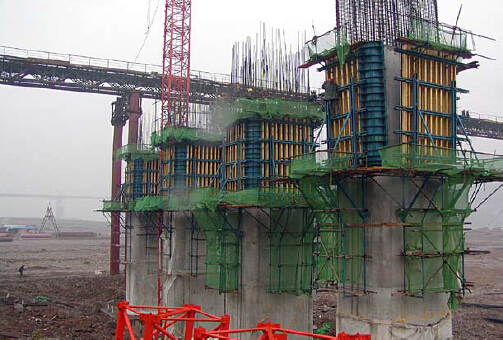
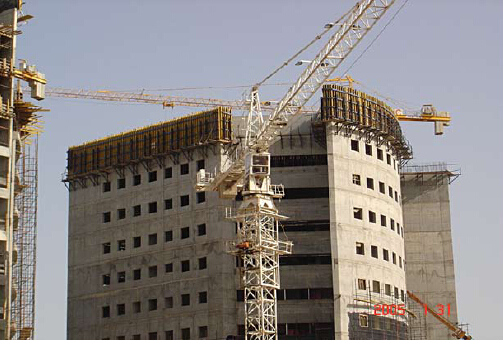
- Q: What are the factors to consider when selecting steel formwork for a project?
- When selecting steel formwork for a project, there are several factors to consider. Firstly, the size and complexity of the project should be taken into account. The steel formwork should be able to accommodate the specific dimensions and requirements of the project. It is important to consider the shape and design of the structure, as well as any unique features or details that may require customized formwork. The strength and durability of the steel formwork are crucial factors. It should be able to withstand the weight and pressure of the concrete during pouring and curing. Steel formwork with high load-bearing capacity and resistance to deformation is desired. Additionally, the formwork should be able to resist rust and corrosion, especially in areas with high humidity or exposure to water. The ease of assembly and disassembly is another important consideration. Steel formwork that can be quickly and efficiently assembled and dismantled can save time and labor costs. The formwork should have a user-friendly design, with clear instructions and minimal tools required for installation. Compatibility with other construction equipment and processes, such as cranes or concrete pumps, should also be considered. The reusability of the steel formwork is another factor to consider. If the project requires multiple pours or if there are future projects that may benefit from the same formwork, it is important to select formwork that can be easily dismantled, cleaned, and reused. This not only reduces waste and environmental impact but also provides cost savings in the long run. The availability and cost of the steel formwork should also be taken into account. It is important to choose a supplier or manufacturer that can provide the required quantity of formwork within the project's budget and timeframe. Comparing prices and quality from different suppliers can help in selecting the most cost-effective option. Lastly, safety should always be a top priority. The steel formwork should meet the necessary safety standards and regulations. It should be stable, secure, and able to withstand potential accidents or mishaps during the construction process. Additionally, the formwork should provide adequate protection for workers, such as guardrails or safety nets, to prevent falls or injuries. By considering these factors, the selection of steel formwork for a project can be done in a well-informed and efficient manner, ensuring the success and quality of the construction process.
- Q: What are the considerations when designing steel formwork for culverts?
- When designing steel formwork for culverts, several considerations need to be taken into account. Firstly, the formwork must be strong and durable enough to withstand the pressures exerted by the concrete during the pouring and curing process. It should be able to support the weight of the concrete without warping or collapsing. Additionally, the formwork should be designed to allow for proper drainage and prevent the occurrence of any water accumulation or pockets within the culvert. Adequate provision for weep holes and outlets should be made to ensure smooth water flow. The geometry and dimensions of the culvert must be carefully considered when designing the formwork. It should be designed to accurately shape the culvert, ensuring that it conforms to the desired size and shape specifications. This may involve the use of adjustable panels or modular systems to accommodate different culvert sizes and configurations. Another important consideration is ease of assembly and disassembly. The formwork should be designed in a way that allows for quick and efficient installation and removal. This can help save time and labor costs during construction. Lastly, safety is a crucial consideration when designing steel formwork for culverts. Adequate precautions should be taken to ensure the stability of the formwork during construction, preventing any accidents or injuries. This may involve incorporating proper bracing, anchoring, and support systems to maintain the integrity of the formwork structure. Overall, the considerations when designing steel formwork for culverts include strength, drainage, geometry, ease of assembly, and safety. By addressing these factors, a well-designed formwork system can facilitate the construction of durable and functional culverts.
- Q: Can steel formwork be customized for specific project requirements?
- Yes, steel formwork can be customized for specific project requirements. Steel is a highly versatile material that can be easily molded and shaped according to the specific needs of a project. This allows for the creation of various sizes, shapes, and designs to accommodate different construction requirements. Steel formwork can be easily modified or adjusted on-site to meet the specific dimensions and specifications of a project. Additionally, steel formwork can also be pre-fabricated off-site, where it can be tailored to the exact requirements of the project before being transported to the construction site. This customization of steel formwork ensures that it can be effectively used in a wide range of construction projects, including complex structures, high-rise buildings, bridges, tunnels, and more.
- Q: How is steel formwork manufactured?
- The desired formwork structure is created by shaping and assembling steel components through a series of processes in the manufacturing of steel formwork. High-quality steel is first chosen and then cut and shaped into panels, beams, and connectors. To fabricate the panels, steel sheets are cut to the required size and shape using specialized cutting tools like shears or plasma cutters. These panels are then further processed to create necessary openings for connectors and accessories. Once the panels are prepared, they are assembled using connectors and fasteners. Welding, bolting, or riveting may be used depending on the specific design and requirements of the formwork. The connections are made carefully to ensure the strength and stability of the steel formwork structure. Beams and other support components are also included in the steel formwork. These are fabricated separately and integrated into the formwork system during assembly. Beams are designed to bear heavy loads and provide additional stability. After assembly, a quality inspection is conducted to ensure that the steel formwork meets required standards and specifications. Defects such as cracks or deformations are checked for, and the accuracy of dimensions and connections is verified. Once the steel formwork passes inspection, it is typically surface-treated to enhance durability and resistance to corrosion. Techniques like galvanizing or painting create a protective layer on the steel surface. In summary, the manufacturing process of steel formwork involves precision cutting, shaping, and assembling of steel components to create a strong and reliable system for concrete construction. The use of high-quality materials and attention to detail ensures that steel formwork meets the demands of various construction projects, providing a robust and reusable solution for concrete formwork needs.
- Q: What are the considerations when designing steel formwork for retaining structures?
- When designing steel formwork for retaining structures, there are several important considerations that need to be taken into account. Firstly, the structural stability of the formwork needs to be ensured, as it will be subjected to significant loads and pressures from the weight of the concrete and the earth it is retaining. The formwork needs to be designed to withstand these loads without deformation or failure. Additionally, the formwork should be easy to assemble, disassemble, and adjust. This is important for efficiency during construction and for future maintenance or repairs if needed. The design should allow for quick and easy installation of the formwork system. Another consideration is the durability of the formwork. Steel formwork should be resistant to corrosion, as it will be exposed to moisture from the concrete. Proper surface treatment and protective coatings should be applied to ensure its longevity. Furthermore, the formwork should be designed to provide a smooth and consistent finish to the concrete. This is important for the aesthetic appearance of the retaining structure and for ensuring the desired structural integrity. Lastly, cost-effectiveness is an important consideration. The design of the steel formwork should aim to minimize material usage and labor costs, while still meeting the required performance and safety standards. Overall, when designing steel formwork for retaining structures, the considerations include structural stability, ease of assembly and adjustment, durability, concrete finish quality, and cost-effectiveness.
- Q: What are the different types of edge protection used with steel formwork?
- To ensure safety and prevent accidents on construction sites, various types of edge protection are utilized with steel formwork. Here are some commonly used options: 1. Edge protection barriers: These sturdy barriers, typically constructed from materials like steel or aluminum, are installed along the formwork's edges. Their purpose is to physically obstruct workers from unintentionally falling off. These barriers are adjustable, making them easy to install and remove as needed. 2. Toe boards: Usually made of wood or steel, toe boards are positioned along the lower edge of the formwork. Their role is to act as a barrier, preventing tools, equipment, or debris from falling off. Additionally, they serve as a visual reminder for workers to exercise caution near the edge. 3. Handrails: Attached to vertical posts, handrails are horizontal bars placed along the formwork's edges. They offer workers a secure grip, aiding in balance and stability, especially when working at elevated heights. Safety regulations often mandate the installation of handrails in specific situations. 4. Safety nets: These nets are positioned beneath the formwork to catch any falling objects or debris. Typically crafted from robust mesh material, safety nets are designed to absorb the impact of such items. They prove especially beneficial during activities where there is a risk of objects falling off, such as concrete pouring or formwork removal. 5. Harnesses and lifelines: In high-risk scenarios, workers may be required to wear harnesses and employ lifelines to safeguard against falls. These systems consist of a harness worn by the worker, which is connected to a securely anchored lifeline. Harnesses and lifelines provide an additional layer of protection when edge protection alone may not suffice. It is important to consider project-specific requirements, local regulations, and the level of risk involved when selecting edge protection measures. Construction companies must thoroughly assess site conditions and implement appropriate measures to ensure worker safety.
- Q: How does steel formwork accommodate for different concrete pouring methods?
- Steel formwork is highly versatile and can easily accommodate different concrete pouring methods. Its modular design allows for easy adjustment and reconfiguration to match the specific requirements of each pouring method. For instance, when using the traditional method of pouring concrete, the steel formwork can be assembled and secured in place to create a sturdy mold for the concrete. Alternatively, when employing the slip forming method, the steel formwork can be continuously moved upward as the concrete is poured, ensuring a seamless and uniform construction process. Overall, steel formwork provides the flexibility and adaptability needed to accommodate various concrete pouring methods effectively.
- Q: Can steel formwork be used for structures with high thermal insulation requirements?
- No, steel formwork is not typically used for structures with high thermal insulation requirements.
- Q: What are the considerations when designing steel formwork for architectural canopies?
- When it comes to designing steel formwork for architectural canopies, there are several important factors to consider. These factors are as follows: 1. Structural Integrity: It is crucial to design the formwork in a way that can withstand the various loads imposed on the canopy, including dead loads, live loads, and potential additional loads such as hanging fixtures. The aim is to make the steel formwork sturdy enough to ensure the stability and safety of the canopy. 2. Aesthetic Appeal: Architectural canopies are often created to enhance the overall visual appeal of a building. Therefore, the steel formwork should be designed in a manner that complements the desired aesthetics of the canopy. This can involve incorporating decorative elements, like patterns or textures, into the formwork design. 3. Ease of Installation: The formwork should be designed to be easily and efficiently installed. This can be achieved by using modular components that can be quickly and easily assembled on-site. It is also important to consider the weight and size of the formwork elements to ensure safe handling and installation. 4. Durability and Maintenance: The steel formwork must be designed to withstand the environmental conditions it will be exposed to. This may involve incorporating protection against corrosion, UV radiation, and other factors that can cause deterioration. Additionally, the formwork should be designed for easy maintenance and repair if necessary. 5. Functionality: The formwork needs to be designed to accommodate any specific functional requirements of the canopy. This can include providing space for utility connections, like lighting or drainage systems, or incorporating features such as rainwater collection systems. 6. Cost-effectiveness: The design of the steel formwork should take into account the overall cost of the canopy project. This includes not only the initial cost of the formwork but also factors such as ease of transportation and installation, as well as long-term maintenance costs. In conclusion, creating steel formwork for architectural canopies requires a careful balance between structural integrity, aesthetics, functionality, and cost-effectiveness. By considering these factors, architects and engineers can ensure the successful implementation of visually appealing and structurally sound canopies.
- Q: Can steel formwork be used for both cast-in-place and precast concrete structures?
- Yes, steel formwork can be used for both cast-in-place and precast concrete structures. Steel formwork is versatile and can be easily adjusted and reused for different projects, making it suitable for both construction methods.
Send your message to us
Single-Side Climbing Bracket for formwork and scaffolding systems
- Loading Port:
- Tianjin
- Payment Terms:
- TT OR LC
- Min Order Qty:
- 50 m²
- Supply Capability:
- 1000 m²/month
OKorder Service Pledge
OKorder Financial Service
Similar products
Hot products
Hot Searches
